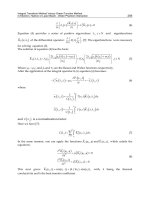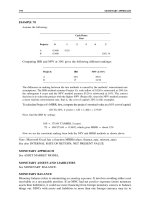- Trang chủ >>
- Khoa Học Tự Nhiên >>
- Vật lý
OBJECT-ORIENTED ANALYSIS AND DESIGN CONCEPTS OF SPACE AND TIME Phần 10 pptx
Bạn đang xem bản rút gọn của tài liệu. Xem và tải ngay bản đầy đủ của tài liệu tại đây (66.91 KB, 10 trang )
REFERENCES
109
DAHL, O.J. and NYGAARD, K., 1966, SIMULA—an Algol-based simulation language.
Communications of the ACM, 9, 671–8.
DEAN, T.L. and MCDERMOTT, D.V., 1987, Temporal data base management. Artificial
Intelligence, 32, 1–55.
DUTTON, G., 1987, Proceedings of the First International Study on Topological Data Structures
for Geographical Information Systems, Reading MA: Addison-Wesley; Harvard Papers on
GIS, Cambridge MA: Harvard University Press.
DYKES, J., 1997, Exploring spatial data representations with dynamic graphics. Computers &
Geosciences, 23(4), 475–82.
EASTERFIELD, M., 1993, Personal communication.
EFFENBERG, W.W., 1992, Time in spatial information systems, First Regional Conference
on GIS Research in Victoria and Tasmania, Ballarat, Victoria.
EGENHOFER, M.J. and AL-TAHA, K.K., 1992, Reasoning about gradual changes of
topological relationships, in FRANK, A.U., CAMPARI, I. and FORMENTINI, U. (eds)
Theories and Methods of Spatio-Temporal Reasoning in Geographic Space, London:
Springer-Verlag, pp. 196–219.
ERWIG, M., SCHNEIDER, M. and GÜTING, R.H., 1997, Temporal and spatio-temporal data
models and their expressive power. Informatik Berichte, 225(12), Fern Universität.
ERWIG, M., SCHNEIDER, M., GÜTING, R.H. and VAZIRGIANNIS, M., 1997, Spatio-
temporal data types: an approach to modelling and querying moving objects in databases.
Informatik Berichte, 224(12), Fern Universität.
FAYYAD, U., PIATESTKY-SHAPIRO, G., SMYTH, P. and UTHURUSAMY, R. (eds) 1996,
Advances in Knowledge Discovery and Data Mining, Menlo Park CA: AAI Press/MIT
Press.
FEDRA, K., 1992, Interactive Environmental Software: Integration, Simulation, and
Visualisation. IIASA RR-92–10, Vienna: International Institute for Applied Systems
Analysis.
FISHER, P., 1997, Concepts and paradigms of spatial data, in CRAGLIA, M. and COUCLELIS,
H. (eds) Geographic Information Research: Bridging the Atlantic, London: Taylor & Francis,
pp. 297–307.
FRANK, A.U., 1994, Qualitative temporal reasoning in GIS—ordered time scales, Proceedings
of the SDH’94 Conference, Vol. 1, pp. 410–30.
GARDELS, K., 1992, SEQUOIA 2000: new geographic information management
technologies for global change research, Proceedings of the EGIS’92 Conference, Vol. 2,
pp. 922–9.
GATRELL., A., 1983, Distance and Space: A Geographical Perspective, Oxford: Clarendon
Press.
GLYMOUR, C., MADIGAN, D., PREGIBON, D. and SMYTH, P., 1997, Statistical themes
and lessons for data mining. Data Mining and Knowledge Discovery, 1, 11–28.
GOLLEDGE, R.G. and STIMSON, R.J., 1997, Spatial Behaviour: A Geographic Perspective,
New York: Guilford Press.
GRAHAM, I., 1994, Object-Oriented Methods, London: Addison-Wesley.
HÄGERSTRAND, T., 1975, Space, time and human conditions, in KARLQVIST, A.,
LUNQVIST, L. and SNICKARS, F. (eds) Dynamic Allocation of Urban Space, Farnborough:
Saxon House, pp. 3–14.
HALL, E., 1966, The Hidden Dimension, London: Bodley Head.
HARVEY, D., 1969, Explanation in Geography, New York: St Martin’s Press.
HAZELTON, N.W.J., LEAHY, F.J. and WILLIAMSON, I.P., 1990, On the design of temporally
referenced 3-D geographic information systems: Development of four-dimensional GIS,
Proceedings of the GIS/LIS’90 Conference, pp. 357–72.
JACKSON, R.W., 1994, Object-oriented modeling in regional science: an advocacy view. Papers
in Regional Science, 73(4), 1–21.
JACOBSON, I., CHRISTERSON, M., JONSSON, P. and OVERGARRD, G., 1992, Object-
Oriented Software Engineering, Workingham: Addison Wesley.
REFERENCES
110
JAMMER, M., 1969, Concepts of Space, Cambridge MA: Harvard University Press.
JOHNSON, D. and KEMP, Z., 1995, Enhancing a GIS with temporal capabilities, Proceedings
of GISRUK’95, Extended Abstracts, pp. 25–6.
JONES, S. and MASON, P.J., 1980, Handling the time dimension in a data base, Proceedings
of the International Conference on Data Bases, pp. 65–83.
JONES, S., MASON, P.J. and STAMPER, R., 1979, LEGOL 2.0: a relational specification
language for complex rules. Information Systems, 4(4), 293–305.
JONES, S.B., 1945, Boundary-Making: A Handbook for Statesmen, Treaty Editors and
Boundary Commissioners, Washington DC: Carnegie Endowment for International Peace.
KARLQVIST, A., LUNQVIST, L. and SNICKARS, F. (eds) 1975, Dynamic Allocation of
Urban Space, Farnborough: Saxon House.
KEMP, Z. and KOWALCZYK, A., 1994, Incorporating the temporal dimension in a geographical
information system, in WORBOYS, M.F. (ed.) Innovations in GIS, London: Taylor & Francis.
KIM, W., 1991, Object-oriented database systems: strengths and weakness. Journal of Object-
Oriented Programming, July/Aug, 21–3.
KIM, W. and LOCHOVSKY, F.H., 1989, Object-Oriented Concepts, Applications and
Databases, Reading MA: Addison-Wesley.
KRAAK, M. and MACEACHREN, A.M., 1994, Visualization of the temporal component of
spatial data, Proceedings of the SDH’94 Conference, Vol. 1, pp. 391–409.
KRASNER, G., 1981, The Smalltalk-80 virtual machine. Byte, 6(8), 12–20.
KUCERA, G.L., 1996, Temporal Extensions to Spatial Data Models: Final Report, US Army
Construction Engineering Research Laboratory.
LANGRAN, G., 1988, Temporal GIS design tradeoffs, Proceedings of the GIS/LIS’88
Conference, pp. 890–99.
LANGRAN, G., 1989, A review of temporal database research and its use in GIS applications.
International Journal of Geographical Information Systems, 3(3), 215–32.
LANGRAN, G., 1992a, Time in Geographic Information Systems, London: Taylor & Francis.
LANGRAN, G., 1992b, States, events, and evidence: the principle entities of a temporal GIS,
Proceedings of the GIS/LIS’92 Conference, Vol. 1, pp. 416–25.
LANGRAN, G., 1993, Issues of implementing a spatiotemporal system. International Journal
of Geographical Information Systems, 7(4), 305–14.
LAPRADELLE, P. DE, 1928, La Frontière: Etude de Droit International (The Boundary: A
Study of International Law), Paris: Les Editions Internationales.
LAURINI, R. and THOMPSON, D., 1992, Fundamentals of Spatial Information Systems, San
Diego CA: Academic Press.
LENNTORP, B., 1976, Paths in Space-Time Environments: A Time-Geographic Study of
Movement Possibilities of Individuals, Lund: Royal University of Lund.
LENNTORP, B., 1978, A time-geographic simulation model of individual activity programmes,
in CARLSTEIN, T., PARKES, D. and THRIFT, N. (eds) Timing Space and Spacing Time,
Vol. 2, Human Activity and Time Geography, Lund: Royal University of Lund, pp. 162–80.
LOOMIS, M.E.S., 1992, Object versioning. Journal of Object-Oriented Programming, Jan,
40–43.
LUM, V.P., DADAM, P., ERBE, R., GUENAUER, J., PISTOR, P., WALCH, G., WERNER, H.
and WOODFILL, J., 1984, Designing DBMS support for the temporal dimension,
Proceedings of the ACM SIGMOD Conference on Management of Data, pp. 115–30.
McCoRMIcK, B.H., DEFANTI, T.A. and BROWN, M.D., 1987, Visualisation in scientific
computing. SIGGRAPH Computer Graphics Newsletter, 21(6).
MACEACHREN, A.M., 1995, How Maps Work: Representation, Visualization, and Design,
New York: Guilford Press.
MACEACHREN, A.M. and TAYLOR, D.R.F., 1998, Visualization in Modern Cartography,
London: Pergamon.
MACEACHREN, A.M., WACHOWICZ, M., EDSALL, R., HAUG, D. and MASTERS, R.,
1999, Constructing knowledge from multivariate spatiotemporal data: integrating GVis with
KDD methods. International Journal of Geographical Information Sciences, in Press.
REFERENCES
111
MAKIN, J., 1992, An object-oriented simulation of a complex geographical system using GIS,
MSc dissertation (unpublished), University of Edinburgh.
MÅRTENSSON, S., 1978, Time allocation and daily living conditions: comparing regions,
in CARLSTEIN, T., PARKES, D. and THRIFT, N. (eds) Timing Space and Spacing
Time, Vol. 2, Human Activity and Time Geography, Lund: Royal University of Lund,
pp. 181–97.
MILLER, H.J., 1991, Modelling accessibility using space-time prism concepts within
geographical information systems. International Journal of Geographical Information
Systems, 5(3), 287–301.
MILNE, P., MILTON, S. and SMITH, J., 1993, Geographical object-oriented databases—a
case study. International Journal of Geographical Information Systems, 7(1), 39–55.
MUELLER, T. and STEINBAUER, D., 1983, Eine Sprachschnittstele zur Versionenkontrolle
in CAM-Datanbaken, in Informatik-Fachberichte, Berlin: Springer-Verlag, pp. 76–95.
NEWELL, R.G. and BATTY, P.M., 1993, GIS databases are different, Proceedings of the AGI’93
Conference, pp. 3.2.1–3.2.4.
NEWELL, R.G., THERIAULT, D.G. and EASTERFIELD, M., 1994, Temporal GIS—modelling
the evolution of spatial data in time. Smallworld Technical Report, Paper 6.
NIST, 1991,X3/SPARC/DBSSG/OODBTG: Final Technical Report of the American National
Standards Institute. Gaithersburg MD: National Institute of Standards and Technology.
ODMG, 1994, Response to the March 1994 ODMG-93 commentary. SIGMOD Record, 23(3),
3–7.
OLANDER, L. and CARLSTEIN, T., 1978, The study of activities in the quaternary sector,
in CARLSTEIN, T., PARKES, D. and THRIFT, N. (eds) Timing Space and Spacing
Time, Vol. 2, Human Activity and Time Geography, Lund: Royal University of Lund,
pp. 198–213.
ORNSTEIN, R.E., 1969, On the Experience of Time, London: Penguin.
PARKES, D. and THRIFT, N., 1980, Times, Spaces, and Places: A Chronogeography
Perspective, Chichester: John Wiley.
PEUQUET, D., 1994, It’s about time: a conceptual framework for the representation of temporal
dynamics in geographic information systems. Annals of the Association of American
Geographers, 84(3), 441–61.
PEUQUET, D. and WENTZ, E., 1994, An approach for time-based analysis of spatio-temporal
data. Proceedings of the SDH’94 Conference, Vol. 1, pp. 489–504.
PRED, A., 1977, The choreography of existence: comments on Hägerstrand’s time geography
and its usefulness. Economic Geography, 53, 207–221.
PRESCOTT, J.R.V., 1987, Political Frontiers and Boundaries, London: Unwin Hyman.
QIAN, L., WACHOWICZ, M., PEUQUET, D. and MACEACHREN, A.M., 1997, Data
processing operations for visualization and analysis of space-time data in GIS. Proceedings
of GIS/LIS’97.
RACKHAM, L.J., 1987, The creation of a prototype relational database for public boundaries
and administrative areas in Scotland, MSc dissertation (unpublished), University of
Edinburgh.
RACKHAM, L.J., 1992, Development of a system for the management and supply of data on
administrative areas and public boundaries, Updating of Digital Maps and Topographic
Databases, Proceedings of the third meeting of CERCO Working Group IX, pp. 1–13.
RAMACHANDRAN, B., 1992, Modelling temporal changes in the structure of real-world
entities within a GIS environment using an object-oriented approach, MSc dissertation
(unpublished), University of Edinburgh.
REED, D., 1978, Naming and synchronization in a decentralized computer system, PhD
dissertation (unpublished), MIT.
RENOLEN, A., 1996, History graphs: conceptual modelling of spatiotemporal data, Proceedings
of Brno GIS Conference.
ROJAS-VEGA, E. and KEMP, Z., 1994, Object-orientation and spatial data modelling: a formal
approach. Poster Session at the UKRGIS’94 Conference.
REFERENCES
112
RUBENSTEIN, R. and HERSH, H., 1984, The Human Factor: Designing Computer Systems
for People, Bedford TX: Digital Press.
RUMBAUGH, J, BLAHA, M., PREMERLANI, W., EDDY, F. and LORENSEN, W., 1991,
Object-Oriented Modelling and Design, Englewood Cliffs NJ: Prentice Hall.
SCHNEIDER, R. and KRIEGEL, H.P., 1992, Indexing the spatio-temporal monitoring of a
polygon object, Proceedings of the SDH’92 Conference, Vol. 1, pp. 209–20.
SHLAER, S. and MELLOR, S.J., 1988, Objected-Oriented Systems Analysis: Modeling the
World in Data, Englewood Cliffs NJ: Prentice Hall.
SHOHAM, Y. and GOYAL, N., 1988, Temporal reasoning in artificial intelligence, in SHROBE,
H.E. and the American Association for Artificial Intelligence (eds) Exploring Artificial
Intelligence: Survey Talks from the National Conferences on Artificial Intelligence, San
Mateo CA: Morgan Kaufmann.
SNODGRASS, R.T., 1987, The temporal query language TQuel. ACM Transactions on Database
Systems, 12(2), 247–98.
SNODGRASS, R.T., 1990, Temporal databases: status and research directions. SIGMOD Record,
19(4), 83–9.
SNODGRASS, R.T., 1992, Temporal databases, in FRANK, A.U., CAMPARI, I. and
FORMENTINI, U. (eds) Theories and Methods of Spatio-Temporal Reasoning in Geographic
Space, London: Springer-Verlag, pp. 22–64.
SNODGRASS, R.T. and AHN, I., 1985, A taxonomy of time in databases, Proceedings of the
ACM-SIGMOD Conference on Management of Data, pp. 236–46.
SNODGRASS, R.T. and AHN, I., 1986, Temporal databases. Computer, 19(9), 35–42.
SNODGRASS, R.T., AL-TAHA, K. and Soo, M.D., 1993, Bibliography on spatiotemporal
databases. SIGMOD Record, 17(1), 10–21.
Soo, M.D., 1991, Bibliography on temporal databases. SIGMOD Record, 20(1), 14–23.
STONEBRAKER, M., 1987, The design of the POSTGRES storage system, Proceedings of
the Very Large Databases Conference, pp. 289–300.
STONEBRAKER, M. and MOORE, M., 1996, Object-Relational DBMS: The Next Great Wave,
San Francisco CA: Morgan Kaufmann.
STROUSTRUP, B., 1988, What is object-oriented programming? IEEE Software, May,
10–20.
SVENSSON, P. and HUANG, Z., 1991, Geo-SAL: a query language for spatial data analysis,
Proceedings ofSSD’91, pp. 119–40.
TANSEL, A.U., CLIFFORD, J., GADIA, S., JAJODIA, S., SEGEV, A. and SNODGRASS,
R., 1993, Temporal Databases—Theory, Design, and Implementation. Redwood City CA:
Benjamin/Cummings.
THEWESSEN, T., VAN DE VELDE, R. and VERLOUW H., 1992, European groundwater
threats analyzed with GIS. GIS Europe, 1(3), 28–33.
VAN HOOP, S. and VAN OOSTEROM, P., 1992, Storage and manipulation of topology in
POSTGRES, Proceedings of the EGIS’92 Conference, Vol. 2, pp. 1324–36.
VERBURG, P.H., KONING, G.H.J., KOK, K., VELDKAMP, A., FRESCO, L.O. and BOUMA,
J., 1997, Quantifying the spatial structure of land use change: an integrated approach data,
Proceedings of the International Conference on Geo-Information for Sustainable Land
Management, pp. 1–9.
WACHOWICZ, M. and BROADGATE, M.L., 1993, A significant challenge: prediction of
environmental changes using a temporal GIS, Proceedings of the AGI’93 Conference, pp.
2.25.1–2.25.5.
WACHOWICZ, M., PEUQUET, D.J. and MACEACHREN, A.M., 1998, Integrating data mining
and GVis for exploring spatio-temporal data, Proceedings ofGISRUK’98.
WASSERMAN, A.I., PIRCHER, P.A. and MULLER, R.J., 1990, The object-oriented structure
design for software design representation. IEEE Computer, Mar, 50–62.
WEGNER, P. and ZDONIK, S.B., 1988, Inheritance as an incremental modification mechanism
or what like is and isn’t like, Proceedings of ECOOP’88, pp. 55–7.
REFERENCES
113
WORBOYS, M.F., 1994, Unifying the spatial and temporal components of geographical
information, Proceedings of the SDH’94 Conference, Vol. 1, pp. 505–517.
WORBOYS, M.F., HEARNSHAW, H. and MAGUIRE, D., 1990, Object-oriented data
modelling for spatial databases. International Journal of Geographical Information Systems,
4(4), 369–83.
115
absolute representation for versions 51
abstract data type (ADT) 94
active object 34
ADA 29
Advanced Information on Management Project 40
aggregation relationship 82
AI programming environments 29
ALGOL 28
animated maps 90
ANSI 32
apoala project 95
ARC/INFO 19
archaeology 11, 14
ART 29
attribute 37
collection attribute 82
derived attribute 82
invariant attribute 37
non-version significant attribute 37
reference attribute 82
version-significant attribute 37, 51
attribute versioning 10
backward-oriented approach 51
backward-oriented accumulative approach 52
Bayesian classification 35
bitemporal element 41
block sharing 42
Booch’s object-oriented method 33–9
dynamic model 33
logical model 33
physical model 33
static model 33
boundary changes in position
natural changes 60
man-made alterations 60
attachment 60
boundary commission 58, 83
boundary disputes 60
Boundary Line Data Management System 6
boundary-making process 56, 81
boundary-making events 56
branching configuration 21
C++ 32
cadastral mapping 10
CASE tools 31, 39
change 33
long-term changes 22, 24, 52
medium-term changes 22, 24
short-term changes 22, 24
CHOROCHRONOS project 93
chronon 38
class 37
generic class 61
versioned class 62
unversioned class 62
class diagrams 65, 69, 71, 74, 76
class properties 66, 72, 77
classical categorisation 35
classification approaches 35
client-server architecture 64
climate maps 35
Coad and Yourdon approach 33
common LOOPS 29
communication models 96
conceptual clustering 35
constraint
capability constraints 25, 59
coupling constraints 25, 59
authority constraints 25
conversion of land use and its effects (CLUE
model) 1
CORBA 32
Index
INDEX
116
data mining 94
data model 45
data model changes 38, 48
data model evaluation 53
database functionalities 40
date
operative date 59
effective date 59
DCE 32
destructor operation 34
dimensional dominance 9
space-dominant representations 9
main characteristics 10
time-dominant representations 11
main characteristics 12
space-time representations 12, 17
main characteristics 15
discrete encoding of time 38
distributed GIS 39, 96
entity 4, 46
individual entity 20
ensemble of entities 20
entity-relationship diagram 33
environmental change 52
environmental data 11
event 20, 22
administration 60
allocation 58
delimitation 59
demarcation 60
event-oriented representation 23
episode 20, 24
European Groundwater Project 1
evidence 20, 24
evolution of public boundaries
in definition 56
in position 57
in the state functions 57
execution
archiving scenario 76
evolution tracking scenario 70, 72
public boundary entry scenario 67
update scenario 75
explanation task 46
exploratory analysis 95
extended-relational databases 31
FLAVOURS 29
foreign key 82
forward-oriented approach 52
forward-oriented accumulative approach 52
four-dimensional representation 4
garbage collection 82
gemstone 30, 82
generalisation 37, 59
geographic visualisation 90, 95
geology 11
GeoSystem 40
GIS-based monitoring model 1
GOOD 29
gradual topological change 13
graph 90
GRASS GIS 40
ground feature 58, 61
historical databases 39
historical events of public boundaries 57
historical evolution 21
historical geography 5
historical view 65, 71, 90
hypermedia coordination 69
HOOD 29
ILLUSTRA 12
image schemata 20
independent incremental modification 49, 65 71
indexing 40
inheritance 37, 49, 82
multiple inheritance 83
interaction diagrams 67, 70, 72, 75, 76
interaction user interface 95
interoperable GIS 96
interval-based models 11
inventory data 11
IRIS system 82
iterator operation 34
Jacobson’s method 34
join relationship 84, 86
KEE 29
knowledge discovery in databases (KDD) 94
knowledge domain 36, 56
layer 3, 9
layer models 10
learning new rules 46
level of abstraction 26
level of referential integrity 82
lifespan 23
line generalisation 68
linked list 42
LISP 29
location in space 23
location in time 12
longitudinal configuration 21
LOOPS 29
menu
Allocation menu 85
Allocation—DraftBoundary menu 85, 86
Allocation—GroundFeature menu 85
Application menu 84–6, 88
Assumption menu 84
Assumption—GroundFeature menu 84
Delimitation HistoricalView menu 90
Delimitation—New Boundary menu 87
INDEX
117
Demarcation HistoricalView menu 90
Demarcation—OldBoundary menu 87,
89
Draft Boundary—Delimitation menu 86,
87
GroundFeature menu 88
GroundFeature—Ground Feature Revolu-
tionary State menu 88, 89
GroundFeature Revolutionary State menu 89
New Boundary—Demarcation menu 87
Perambulation menu 89
OldBoundary menu 89
OldBoundary—Old Boundary Revolu-tionary
State menu 89
OldBoundary Revolutionary State—
Perambulation menu 89
Road menu 88
mereing points 68
method 38, 82
trigger update methods 50
mixed models 11
modelling tool 6
modifier operation 34
motif 69
multidimensional scaling algorithm (MDS) 14
mutation 22
navigational charting 10
O2 30
object 36
active object 34
client object 34
passive object 34
server object 34
object identifier 51, 82
object identity (OID) 43
object key 83
object maker 32, 55
object management group (OMG) 32
object-oriented analysis methods 31
object-oriented analysis and design methods 32
choosing a method 32
literature review 27
main modelling constructs 36
object-oriented database systems 30
object-oriented design methods 29
object-oriented programming languages 28
object store 30
OLE 32
OMT method 33
ONTOS 30, 82
OOSD 29
open GIS 96
operations 34
integration 96
data mining 96
ordinal models 14
Ordnance Survey 6, 56
basic maps 60, 99, 100
parliamentary boundary commissions 58
perambulation measurements 60
statutory documents 59
ORION 30
overlapping incremental modification 50, 73
place 17
planning task 46
point-based models 11
pointer 82
polymorphism 38, 83
POSTGRES 31, 40
prediction task 46
primary key 83
prism in Time Geography 18
probe system 82
process 14, 94
macro process 34
micro process 34
process of differentiation 22
processes found in the political boundary
evolution 56
property 35, 37
prototype implementation 81
prototype theory 36
public boundary 55
processes 56
states 57
quadtree structure 40
query language 42
query statement 90
raster models 3
reasoning 46
referential integrity 82
regional science 2
relational databases 31
relative representation for versions 51
representation 45
rollback databases 39
rule 33
scale 24, 59
scenario 36, 63
archiving scenario 74, 89
evolution tracking scenario 68, 86
public entry scenario 64, 83
update scenario 73, 88
schema evolution 38
schema updates 38, 48
schlaer-mellor approach 29
selector operation 34
sequoia 2000 project 40
services 96
Simula 28
simulation modelling 12
salmon growth simulation model 2
shopping behaviour simulation 19
simulation of daily individual activities 16
INDEX
118
Smalltalk 28, 32
Smallworld 19, 30, 39, 90
case tool 81
magik 82, 87
object-oriented features 83
version-managed store-vmds 81, 84
snapshot databases 39
social models 2
soil maps 35
space 17
absolute space 9
relative space 13, 16
space-time entity representation 5
space-time maps 14
space-time path 16, 20–5
configuration 21, 47
creation 58, 84
demise 61, 89
direction 20
elements 20, 47
existence 59, 85–9
identity 20
implementation 83–9
life-span trajectory 21
location 20
main abstractions 47
spatial relationships 59
spatio-temporal data 20
spatio-temporal data types 93
spatio-temporal indexing 40
spatio-temporal objects 93
spatio-temporal semantics 6
spiral model 34
stage
allocation 85
creation 83
creation from an existing object 88
delimitation 86
demarcation 87
relocation of an existing object 89
selecting a ground feature 84
starburst 31
state 20, 57
draft state 59
new state 59
obsolete 61
old state 60
state transition diagram 33
STDM (spatio-temporal data model) 6, 45, 53
access method 53
classes 61, 77
desirable characteristics 53
evaluation 53
evolution in definition 61
methods 66, 69, 75, 76
overview 102
properties 66, 72, 74, 77
scenarios 63–77
version management 77
structural compatibility 36
sub-classing 37
sub-typing 37
table versioning 42
taxonomy of time 39
TEMPEST 12
temporal databases 39
temporal logic 11
time 17
absolute time 11
cyclical time 13
dimension 38
timestamp 10
relative time 13, 16
user-defined data type 12
time change objects 42
Time Geography 5, 16, 19–26
space-time path 16, 20–25
potential path areas 18, 25
Time Geography and GIS 19
time line 12
time map 11
time series 12
topographic mapping 10
topological relationship 13
transaction time 39
transportation network 19
turning points 68
uncertainty 95
ubiquitous computing 96
update-oriented representation 22
atomic updates 37
non-atomic updates 37
update procedures 12, 48, 73, 87, 88
user-defined task 96
utility mapping 10
valid time 39, 41
vector models 3, 10
version 50–52
delta-versions 51
identifiers 51
successor-in-line version 52
version configuration 49
version graph 62
version management approaches 42, 43, 50, 77
version proliferation 78
view 12–17
absolute space-time view 12
integrating absolute and relative views 16
relative space-time view 14, 17
main characteristics 15
visualisation of versions 51









